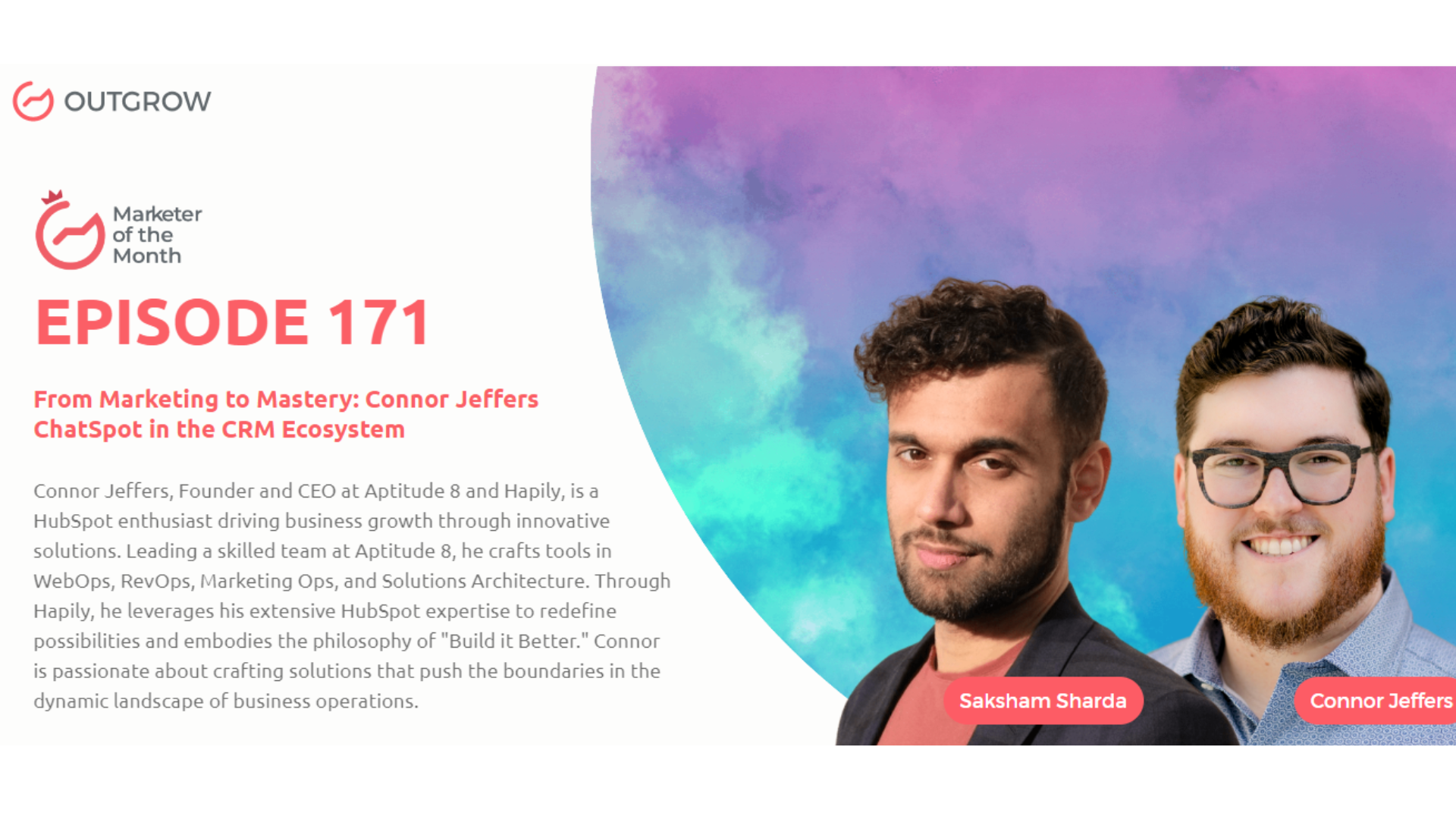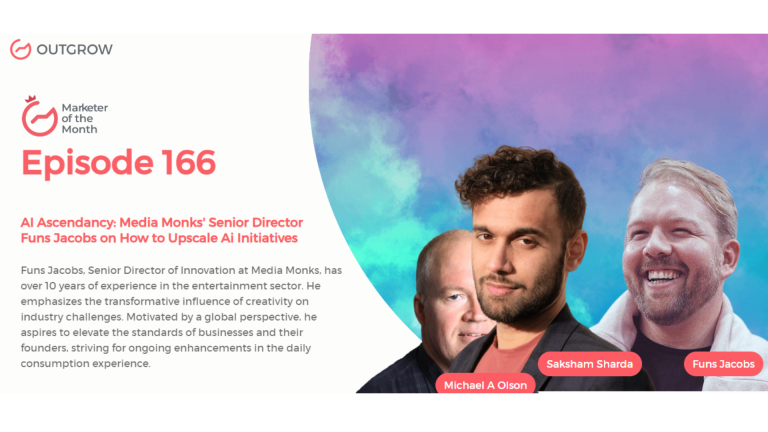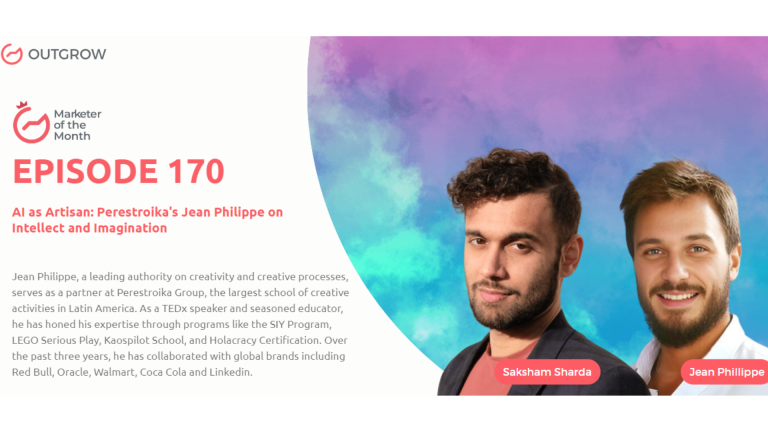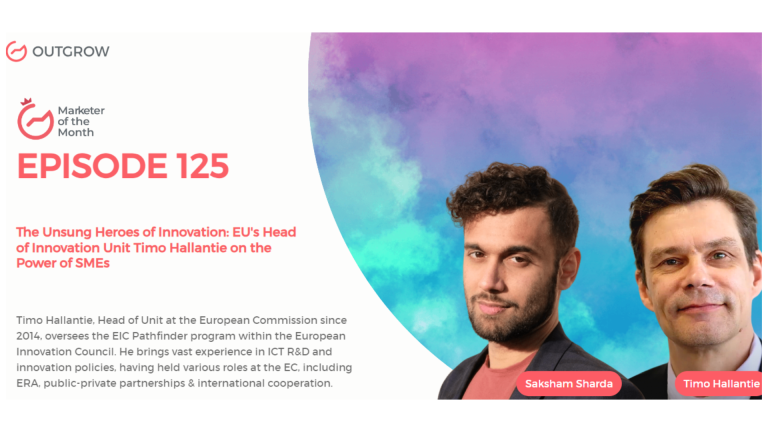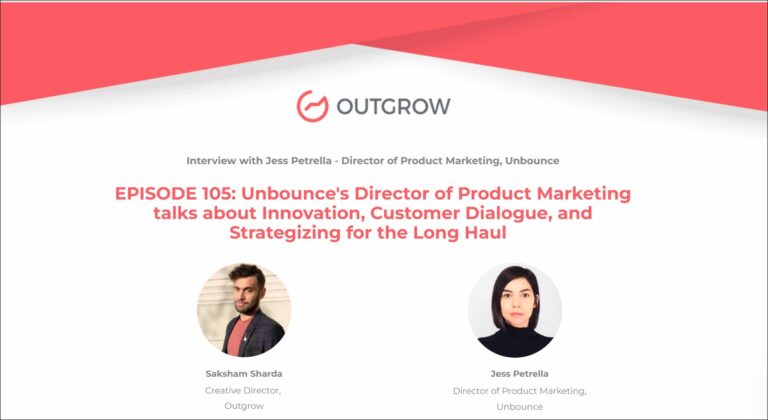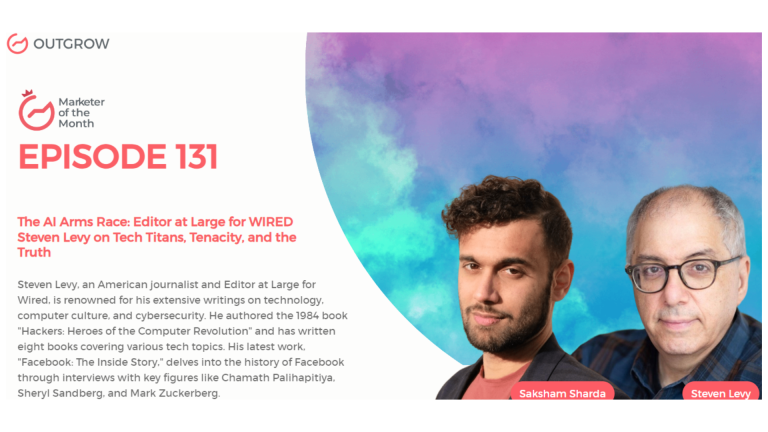Hey there! Welcome to the Marketer Of The Month blog!
We recently interviewed Connor Jeffers for our monthly podcast – ‘Marketer of the Month’! We had some amazing insightful conversations with Connor and here’s what we discussed about-
1. Introduction of ChatSpot, an AI tool within the HubSpot ecosystem.
2. Aptitude 8’s role in building custom applications on HubSpot.
3. Common CRM challenges include messy data and lack of process adherence.
4. HubSpot’s transition from a marketing-centric to a comprehensive CRM platform.
5. Introduction of Custom Objects and Operations Hub for customization and extensibility.
6. User’s transition from resisting change to realizing the CRM’s effectiveness.
About our host:
Dr. Saksham Sharda is the Chief Information Officer at Outgrow.co. He specializes in data collection, analysis, filtering, and transfer by means of widgets and applets. Interactive, cultural, and trending widgets designed by him have been featured on TrendHunter, Alibaba, ProductHunt, New York Marketing Association, FactoryBerlin, Digimarcon Silicon Valley, and at The European Affiliate Summit.
About our guest:
Connor Jeffers, Founder and CEO at Aptitude 8 and Hapily, is a HubSpot enthusiast on a mission to revolutionize business growth. Leading a team of experts in WebOps, RevOps, Marketing Ops, and Solutions Architecture at Aptitude 8, Connor orchestrates the creation of innovative machines to propel customer growth. With Hapily, he productizes his wealth of HubSpot knowledge to push the boundaries of what’s achievable, embodying the ethos of “Build it Better.” Connor’s passion lies in crafting solutions that redefine possibilities in the ever-evolving landscape of business operations.
EPISODE 171: From Marketing to Mastery: Connor Jeffers ChatSpot in the CRM Ecosystem
Table of Contents
The Intro!
Saksham Sharda: Hi, everyone. Welcome to another episode of Outgrow’s Marketer of the Month. I’m your host, Dr. Saksham Sharda, and I’m the creative director at Outgrow. co. And for this month we are going to interview Connor Jeffers, who is the Founder & CEO of Aptitude 8 and Hapily.
Connor Jeffers: Great to be here. Thank you.
Don’t have time to read? No problem, just watch the Podcast!
Or you can just listen to it on Spotify!
The Rapid Fire Round!

Saksham Sharda: So Connor, we are going to start with a rapid-fire round. Just to break the ice. You get three passes in case you don’t want to answer the question, you can just say pass. But try to keep your answers to one word or one sentence only.
Connor Jeffers: Let’s do it.
Saksham Sharda: At what age do you want to retire?
Connor Jeffers: I’d go with never.
Saksham Sharda: How long does it take you to get ready In the mornings?
Connor Jeffers: Like 28 minutes.
Saksham Sharda: The most embarrassing moment of your life.
Connor Jeffers: When I was a kid, I went to a waterpark and did the little surfing thing where it blasts water and you stand on it and I fell and my shorts blasted off.
Saksham Sharda: Favorite color?
Connor Jeffers: Blue.
Saksham Sharda: What time of day are you most inspired?
Connor Jeffers: Really like late at night.
Saksham Sharda: How many hours of sleep can you survive on?
Connor Jeffers: I’ll survive like four or five. They thrive, like probably seven.
Saksham Sharda: Fill in the blank. An upcoming marketing trend is ____.
Connor Jeffers: I mean, I’ll cheat and go like AI-powered content
Saksham Sharda: The city in which the best kiss of your life happened.
Connor Jeffers: I’ll go pass on that one. I guess.
Saksham Sharda: Pick one. Mark Zuckerberg or Elon Musk.
Connor Jeffers: I am going with Elon.
Saksham Sharda: The biggest mistake of your career?
Connor Jeffers: Oh man. There’s a lot. That’s how you learn. I’ll go past. Just because we could spend so much time there. Not so much for shame.
Saksham Sharda: How do you relax?
Connor Jeffers: I like to build Legos like the one behind me. Exactly.
Saksham Sharda: How many cups of coffee do you drink per day?
Connor Jeffers: Two.
Saksham Sharda: A habit of yours that you hate?
Connor Jeffers: I bite my nails.
Saksham Sharda: The most valuable skill you’ve learned in life?
Connor Jeffers: I’ll boil it all down to leadership.
Saksham Sharda: The last one is your favorite Netflix show.
Connor Jeffers: I was really into beef recently. It’s great.
Saksham Sharda: Yeah. I’m gonna give you two more rapid fires because you’re so good at them. The movie do you like watching the most?
Connor Jeffers: I have no idea. I feel like I love quoting movies. It’s hard to pick one, to be honest with you. I probably like fellas.
Saksham Sharda: And the last one is the song you’ve been listening to recently.
Connor Jeffers: I don’t know the name of any songs I’ve been listening to recently, but I hear the same ones on the same. I do a lot of Ziggy Alberts radio in the morning, which is kind of like indie folk stuff, so I hear the same stuff. I have no idea what any of them are called.
The Big Questions!

Saksham Sharda: Well that’s the end of the rapid-fire round. You scored quite well. Are there any of the questions you wanna elaborate on in more detail or do you wanna move on to the longer questions?
Connor Jeffers: I’ll do the one that I just said leadership on because I was thinking about all the different things that I could say there. I think in terms of like the most valuable skill would be rallying people to a cause like garnering, garnering trust, committing to a course of action, and sort of like coordinating and orchestrating people and stuff to move in that direction. And I think that’s valuable whether you are not that I am leading or have ever led a country, but I’d imagine sort of every layer, right? Whether it’s at the highest levels or the lowest levels. Super valuable skill.
Saksham Sharda: So let’s go onto the bigger questions anyway now. So can you share with us your journey like you told us about the leadership, but tell us about the entire journey and the companies you’re working for right now?
Connor Jeffers: Sure, the abbreviated version for me is I started my career in a venture-backed EdTech business outta Toronto called Top Hat. I left school, started working with them, was an SDR, and did some sales stuff. Went to the marketing team, ended up leading marketing for a while, and did that for several years. And then left, went back to Chicago, and worked with a venture studio outta Chicago. So as opposed to sort of a traditional venture model where we’re trying to find companies, trying to find deals, trying to deploy capital into them we had sort of a base of cash and then we were looking at sort of areas we thought were really interesting building prototypes and MVPs for them, trying to launch them in market, sort of get traction. And once we started getting a little bit of traction on them, we’d bring in a founder. And then sort of, we had an in-house development group, a technology group, a sales and marketing group, which I was leading. And we’d sort of help those companies get up in the air and run. So over about a year and a half, we started five different companies. Three of them are still going, employ lots and lots of people have raised a bunch of money doing well. That was a blast. I’ve been chasing that high ever since. Left with one of the other partners at the firm. We had sort of been getting asked by some of the different investors and board members as sort of our Port cos on how come when we come to your company’s board meetings, they have like metrics and funnels and conversion rates and they like to know what’s going on and every other sort of organization I go and work with they have no clue what’s happening. And like no one is on the same page and they can’t answer some of the questions we’re asking. And we’d start to tell them and then they’d be like, sure. Whatever, can you just go help these people out? And so we started doing that a whole bunch and then split off and started sort of a small consulting firm doing a lot of that work. Decided we wanted to do our venture studio again. But found out pretty quickly that, you know, without $10 million in the bank, that was pretty difficult to do. He got an offer from one of our clients to come on full-time. He had just had a baby. It kind of made sense for him and we decided to kind of go our separate ways. Which is when I originally sort of started Aptitude Eight which is a HubSpot technical Services firm. We originally did HubSpot stuff, Salesforce stuff, outreach stuff, sort of all sorts of different tools in the GTM stack. And we sort of saw this opportunity when I was in Chicago at the time, so I knew, knew the Blue Wolf guys, knew the model metrics guys, a lot of the early Salesforce companies that had kind of done well. And as I started to get exposed to HubSpot, sort of two things started to become clear. So one was that HubSpot was kind of on a similar trajectory. They were investing in CRM, they were trying to go and sort of compete with Salesforce more legitimately in the market. But the secondary thing that became clear is all of the existing HubSpot partners were marketing agencies. And they weren’t technical services companies that were building, integrating, and optimizing the platform itself. And so we sort of decided with Aptitude eight that we were going to do that. Aptitude 8 is three and a half years old at this point. And then about a year and a half ago we started looking at the ecosystem side of HubSpot. Built something internally called Eight Labs where we were building sort of apps on top of the platform. I met Dax and Tyrone who were running App Chemists, which was sort of a company building tiny little apps in the HubSpot marketplace and sort of selling them met them, saw the same vision, and then that’s when we sort of decided to do what was originally a eight labs and an extension of Aptitude eight. And then in collaboration with HubSpot Ventures, they invested into what is now happily, and we sort of spun it out of aptitude at its core. So really the long version of the story, if you filter everything down aptitude Eight helps people who use HubSpot build solutions for their particular instance in sort of a one-to-one model. And happily builds products and applications on top of HubSpot that allow any HubSpot customer to sort of add superpowers into their core HubSpot instance. So an eight sort of one-to-one happily is sort of many to many.
Saksham Sharda: And so there is a lot of chatter on HubSpot versus Salesforce. So as someone who has worked with both, how do you break down this big debate?
Connor Jeffers: Yeah, so it’s really interesting, right? I think a lot of people that you’ll see in the HubSpot ecosystem have sort of been all HubSpot all the time, very SMB-focused, and sort of like Salesforce is the big bad wolf. I think it’s a little bit more nuanced than that. I built a lot on Salesforce. To this day, my most technical skill set is still Salesforce. Like I can build anything in Salesforce, I can write Apex, like I started my career on the Salesforce side. And I think that that lends itself to a little bit more of a nuanced view. I think what’s happening is HubSpot is building a lot more, they’re adding a lot more functionality and the product level gaps are starting to get patched, right? And so like a year ago it was, oh, well you can’t even have custom objects in HubSpot. Now you can do that. You can’t even write code in HubSpot. Now you can do that. You can’t even customize the UI in HubSpot. Now you can do that. And so I think that like a lot of these obstacles and barriers just start to continuously get knocked down. And there’s still a couple as of this moment where like if you need hyper level data security, so you’ve got multiple teams, you do hipaa, you deal with PII, you have whatever the sort of the con multiple countries, whatever it is that sort of requires a high level of data security, you’re probably gonna end up on Salesforce. Salesforce has just an incredibly robust suite of data security and data control tools that lend itself to all sorts of problems that lots of people who have worked with Salesforce are accustomed to. But it has the functionality, and it’s powerful. The second layer is if you want to build sort of like your own application, right? So you don’t want to have this CRM or something that has pre-built functionality or pre-powered features, you really wanna say, I’m trying to build something completely custom and I’m just looking for a platform to accelerate doing that. And the reason I wanna do that is I wanna have very discreet screens that someone has to go through in a certain way. I only wanna show certain information. I want to build something specific and tailored. And if you want to do that, Salesforce is the best product in the market to achieve that. If you’re anybody else, and I would put like 99% of organizations sort of like in the other category, right? And that is I’m trying to look for a tool that enables my marketing team, my sales team, and my service team to do their jobs better, be more effective, collaborate, execute, and sort of empower them to do what they wanna do. And I’m willing, and I don’t need to, like, it’s not even, I’m willing to compromise. It’s like I don’t need crazy high levels of custom-built, custom-developed functionality like hubs.is now a very, very viable option. And not only viable, we see for a lot of different organizations, whether you are a PLG-focused organization, but also an inbound-focused organization, you are anything that is more individual and customer-centric versus a purely outbound-driven model HubSpot does better for those organizations. And so it’s not a function of like, oh, well HubSpot’s a little cheaper, it’s a little bit easier to use, it’s a little bit more adoptable by my team. Those are all really good reasons, but there’s also a very good reason, which is like, it works better for my company and it works better for my use case. And that’s true in addition to all of the other sorts of things that people like to talk about.
Saksham Sharda: And how about integrations? How do HubSpot and Salesforce compare when it comes to integrating with other tools and systems commonly used by businesses?
Connor Jeffers: Yeah, so Hubspot has a super giant marketplace the same as Salesforce, right? There’s this huge swath of applications in the Hubsoft ecosystem you can go look at that integrates with sort of every business application under the sun. Salesforce is sort of in the olden days, right? Was the original innovation. Salesforce had lots of innovations, but one of the big innovations that they originally had was around the app marketplace and the app exchange. And being able to have people build on the platform and install stuff. That’s happening in HubSpot. That’s what Happily does as a business. Again, hub HubSpot Ventures portfolio companies like HubSpot’s going in this direction, in’s early days. So really any application that already exists in the ecosystem, you’re gonna find a way to integrate any of those things with HubSpot. Either because they have out-of-the-box integrations that are one-click installs and they add functionality into HubSpot and you can integrate them, right? So whether it’s like a Clickup or an Asana or Greenhouse or whatever it might be that you sort of work with a Slack you want to connect that data in what’s still early, really early days is building applications on top of HubSpot that run natively inside of HubSpot. So for example, we have two apps with Happily that I think are good examples of this. One is Zebra. So Zebra Takes we sort of a super robust Stripe integration. We take your whole Stripe data model, we replicate it in HubSpot. We create subscription objects and transaction objects. We let you create, administer, and manage anything inside of Stripe, all from HubSpot. So if you’re a SaaS company, you can send a quote to somebody, collect a credit card, provision, or subscription, you can automate your renewals, and all that gold stuff. And then you can sort of do upgrades, downgrades, whatever else it might be all from within HubSpot. And that’s like an app built on top of HubSpot as opposed to another product that’s just integrating in. And then we have an Orchestrate, which is all event native event management that we’re launching later this year. And it’s early days for HubSpot apps that are built on top. But in terms of integrations, almost every major business application that you’ll run into, and tons and tons of tiny ones all have integrations into HubSpot. And then what we sort of see on the Aptitude eight side is HubSpot has tons and tons of APIs. They’re adding more and more extensibility functionality every single day. And what we do with eight is sort of do custom integrations, which is beyond, I need this sort of out-of-the-box thing and I need this very, very custom functionality or custom user journey or workflow. And you can build all of that on HubSpot’s extensive APIs, objects, and everything you might wanna have.
Saksham Sharda: So you mentioned that HubSpot has evolved over the years. Could you tell us in more detail, what that looked like from the perspective of Aptitude 8?
Connor Jeffers: Yeah, for sure. So I think the evolution started before we were even in the mix. So I think if you think about HubSpot over time HubSpot sort of originates in, I should pull up my little diagram here that helps me think about this. But the origin is sort of like HubSpot as an organization, right? So HubSpot sort of started in 2006 and from 2006 to 2014, HubSpot’s a marketing software company. So they have landing pages, they have emails, they have contacts, they have list building, all very marketing-centric. And honestly, I think up to 2014, modern-day MailChimp is basically what HubSpot was, right? Super, super basic functional marketing software with sort of their IPO. And they sort of added in the original Sales hub functionality in 2014, that’s when they sort of were this SMB growth software company. So the original sales tool I think was like, it had sequencing, it had email tracking, it had calendar booking, like very, very simple sales level functions. And then in 2017, they launched Service Hub. And so now they had sort of like the marketing piece, the sales piece, some light service piece with ticketing and, and some other functionality there. And that was kind of like what I would call the S-M-B C-R-M product arena, right? So, and that lasted through 2021. And then in 2021 everything kind of changed. And so when I think about what we do at apps to date, what do, and I think apps to date was sort of like early to seeing this trend happen. And then Happily is born out of this, this occurring in and of itself, which is in 2021-22 really big things happened. One is Hubspot launched Custom Objects which you boil down to like one feature, one thing, but it’s huge. ’cause What it means is, instead of you trying to fit your business into HubSpot and like I, what’s gonna be my company, what’s gonna be my tickets? What’s gonna be my deal? And the Cardinal problem to solve was how do I adapt the way I do things into this software that’s gonna help me do them better? Now you can build whatever you want. If you want an order object, if you want a machine object, if you want a factory object, if you want a location object, you can do all of that. You can put whatever you want in the platform, and now you can expand the functionality of HubSpot to any data model, any business, any organization, any structure, and Custom Objects fundamentally change what’s a product with features to a platform with some sort of functionality. And that’s part one. Part two is coded actions, operations hub, and the ability to end serverless functions and run code inside of HubSpot. And so what happens is when you add those two features, you take HubSpot’s world-class sort of automation engine, you take all of their sales, their service, their marketing functionality, but then you extend and expand on all of that functionality by being able to add any level of customization, custom development, custom functionality into the platform itself, that all runs on top of HubSpot. And so not only does it allow for companies like Happily to go and build apps on top of HubSpot and sell them to HubSpot customers, but it allows for companies like Eight to work with organizations that are saying, Hey, I’m trying to deliver this unique custom experience to my end users, and like, how should we do that? And we can say, oh, we can build that for you and we can do it on top of HubSpot. And that’s when you take HubSpot from sort of this S-M-B C-R-M product to a mid-market and enterprise CRM platform that you can build all sorts of really cool functionality on top of.
Saksham Sharda: And so what are some of the organizations you’re working with and what are some of the common challenges that businesses face when implementing and utilizing A CRM? And how do these challenges differ when looking at HubSpot versus Salesforce?
Connor Jeffers: Yeah, I can do some logo drops, but I’ll keep it short. We were with lots of companies that aren’t as famous. So we work with Uber Freight South by Southwest. We did all of the inbounds. So for HubSpot’s annual event, sort of like the website, the ticketing, like all of the functionality that supports the event itself. We built all of that on HubSpot as well. But I think in terms of the types of challenges that organizations typically face, right? You sort of have a base level, everyone has these CRM level challenges, which is like, my data’s a mess, I have no source of truth, I can’t figure out what the right answer is. I’m trying to, like, I have a business process, but maybe it isn’t super well followed. The way we manage our processes is not managed and dictated by the system, but rather like we manage everything in spreadsheets and then just log contacts in the CRM so we can track emails we sent them. Those are kind of like the base-level things. And I think those are universal no matter what product you use, no matter anything you use, you need sort of a core rev ops strategy to manage those things. But I think that those elements are pretty universal. Things that get more interesting that we’re starting to see customers starting to build to get me excited. And this is the kind of stuff that used to be Salesforce only, right? Like, they had Visual Force pages and they had Apex code, and like if you were trying to build a custom application for your business, but the application is intended to serve your users. So it’s supposed to be your salespeople, your service people, something for them to be able to do, whether it’s inventory lookup, whether it’s a return flow, whether it’s a what are some crazy things that we’ve seen pricing calculator, CPQ type stuff, like all of those things, right? If you’re trying to build those applications and you need something custom, Salesforce was the way to go because it was the only way to have sort of the box functionality, even though most of the Salesforce functionality isn’t quite outta the box sort of the native functionality plus custom stuff. And what I get excited about is some of the new features on HubSpot that are very developer friendly, developer-focused customization focus that we’re delivering for customers where we, we just had a client that we went and custom built this entire like booking quoting situation where they sell ad space and the ad units are changing all of the time. Because there’s this sort of, this dynamic inventory, there’s a hundred sales reps, they’re all selling stuff all the time. I could be on the phone with you talking about this placement, and by the time you’re like, okay, cool, I think that sounds good. I’m like, great. Ah, it’s gone. Like somebody else just bought it. And so that’s a dynamic high-speed type of environment. And what we’ve built for them is sort of a custom CRM extension on HubSpot that allows them to be able to dynamically refresh in the background, have sort of A-B-Q type of engine that those sales reps can navigate and refresh with what’s in the inventory and what they can expose. And so that type of a user journey is something that HubSpot just like honestly within the last six or eight months has been capable of building and the speed at which we’re seeing that adapt is so fast. And I think what we’re gonna see is more and more companies realize that the trade-off you used to have was, I’m kind of taking us back to the Salesforce concept, but used to be if I want a high level of customization if I want a high level of extensibility, I need to make tons of compromises on usability. I need to make tons of compromises on accessibility. I need to make tons of compromises on adoption. And that was just like the two sides of the coin. And I think the way that HubSpot’s approaching it today is sort of like, why can’t we do both? And I think they’re executing on both. And I think what we get excited about is seeing more and more organizations realize that they can have their cake and eat it too. And those challenges don’t necessarily mean that you have to go with systems that are gonna slow you down just so that you can power something unique to your experience.
Saksham Sharda: So you also talked about artificial intelligence in the rapid-fire round. In what ways is HubSpot evolving towards that or trying to implement that within it?
Connor Jeffers: Yeah, I’m excited about AI in general, but I think also specifically in CRM and sort of where I focus in, HubSpot for sure. But I think one, you see sort of the outward-facing stuff. So HubSpot now has, I think, live right now, and I’ll try to keep my, what’s secret and beta versus what’s public as clear in my mind as I can. But I think things that exist right now, one, you have sort of like an AI content assistant, so anywhere in HubSpot that you’re building content, whether it’s landing pages, blogs, webpage, emails, whatever it might be, you can highlight different sections. You can have it rewrite stuff, you can have it suggest stuff, you can have it trim things down. Anyone who’s used chat GPT is very similar, right? But imagine that embedded in your content creation flow. So I’m writing something, I’m creating something, I’m writing a blog. I clone that blog and I say rewrite this blog. But instead of it being about what lawnmowers make it about, I started this metaphor thinking I had a really good idea of lawn care equipment and I realized I don’t call it lawn. I know lawnmowers and weed whackers. So rewrite this blog post instead of about lawnmowers, let’s write it about weed whackers, and it’ll spit out a first version for you, right? In the content editor. That’s huge. I think the secondary, that’s all also in the sales tool. So if you have the sales extension in your Gmail account, or if you’re emailing back and forth directly from the CRM, it can first draft email replies for you. It can edit an email reply where you write back to a prospect like an eight-paragraph thing, and you’re like, this doesn’t work. Like, let’s trim this down to a couple of bullets. It’ll do that automatically. And then what we’re seeing that’s early days, but I think I get excited about things like that spot. So ChatSpot Dharmesh, HubSpot, CTO, and one of the founders sort of has this group that is separate from I say separate but inside of HubSpot. But he has his product team that’s all dedicated to chat spot, which is essentially what would happen if we took a natural language chat interface and applied it to CRM. So you can run reports, you can create data, you can query things, you can access pieces. And I think what gets me excited is, and it’s super early days on this stuff, but like a huge function that I did at the very beginning of this business was I would sit down with VPs of sales, VPs of marketing and I would just talk to them about like, what do you want to report on? What do you want it to look like? And we would like to build them the marketing dashboard for the quarter, right? Like, this is how I wanna see this data. Here’s my X-axis, and here’s my Y-axis. They can tell me all of that stuff. What they lack is the hands-on keyboard execution ability to say like, this was Salesforce, but like, how do you build that report? How do I make it look the way I want it to look? What data set do I want to grab? And like, that whole exchange doesn’t need to exist anymore. You can just go straight to that executive and that executive says, I want a report of all of my M QLS from the last quarter with, the Y access being quantity and the X access being weak. And chat spots right now can be like cool, great, boom, here’s a report and that report exists in HubSpot and you can add it to a dashboard. And like that sort of exchange is sort of where I see all CRM user interface stuff going. And the thing that makes me think that HubSpot in particular is very, very well positioned for it is that Salesforce is an amalgamation of products that they have acquired and bought over the last 20 years. And they have slapped a Salesforce logo on, they’ve integrated them sometimes natively, sometimes like kind of janky by just sort of passing data back and forth and hiding the API calls. But HubSpot is one whole code base, one whole feature set. And if you think about it like one database with different user-level functionalities layered on top, what that means is that when HubSpot goes and adds AI functionality, it works across every single piece of the platform and it works across every single user profile. Whereas when Salesforce says, Hey, we wanna add AI functionality, I’m gonna add that to Sales Cloud, I’m gonna add that to Service Cloud, I’m gonna go and develop a completely different thing for Marketing Cloud, a completely different thing for Pardot and a completely different thing for the next product. And what that means is that HubSpot’s ability to rapidly iterate and deploy and put that functionality in front of users, I think is gonna be a lot faster. As anyone who builds software knows, the speed at which you can iterate and go through that cycle time is ultimately what influences how great of a product you can build. And so I’m, I’m excited about the future of sort of HubSpot plus AI and I think CRM plus AI is going to reduce that. I need to be some kind of a technical expert to leverage this technology to tell it what you want and it’ll do it for you.
Saksham Sharda: And is ChatSpot now widely available? What is the extent of implementation at present?
Connor Jeffers: ChatSpot is widely available. I think it’s alpha, it’s not even beta, but you can use it. I think it’s chatspot.ai and it exists right now. You can go to it, you can use it. It’s super betas. If you go in there expecting chat GBT-level magic plus HubSpot you will be disappointed. But if you go in thinking, Hey, I want to interact with this thing and I don’t want to go through the HubSpot AI you’ll be like, whoa, this is pretty amazing. And I think for an Alpha with a handful of product folks and a handful of engineers working on it I think it’s good, it’s more than a proof of concept, but I think it’s an early product that’ll demonstrate what I think the future of most highly technical business applications will be is just like, what if you could reduce it down to I don’t need to build something and design it and add functionality and train my users. Like, think about an expense application, like what, like a sales rep goes there, is like, Hey, I was on this trip, I was meeting with this client, here’s my receipts and like all of that CRM level functionality in the backend. But the complicated part was like, I have to build this whole UI, I have to build all these buttons, I have to train the sales reps how to use it. They have to not lose the link. Like gone. You should have a rep who goes to it, interacts with it, and all of that backend functionality happens. And I think that’s kind of what the future looks like as all of that kind of goes away.
Saksham Sharda: Alright, so switching to Aptitude 8, a little aptitude 8 is known for bringing together experts in web operations, revenue operations, marketing operations, and also solutions architecture. So can you explain how these different areas work together to help businesses grow better for people who are unaware?
Connor Jeffers: Yeah, for sure. It’s funny. I think that for us we even, I think that tagline, I don’t, you’ll have to tell me where you are, where you lifted that so we can go update it. I think that we used to have all of our teams segregated that way. We don’t even look at it that way anymore at all because we’re looking at how we can build on platforms. So what we do ultimately is we help people who are either current HubSpot users or people who are sort of like, we would describe it as HubSpot curious, right? Implement HubSpot, integrate HubSpot, optimize HubSpot, and deliver custom experiences on top. So think about us as I am a sales, a marketing, a service, an operations leader, maybe an executive. I either am, let’s talk about sort of like, I don’t use HubSpot today. I’m a Salesforce user, I’m a Dynamics user. Maybe I don’t use anything. And it’s like I’ve got spreadsheets and NetSuite widgets and custom-built stuff by this IT guy that works here. But like all he does is maintain the system. And I’m trying to sort of deliver a better experience both for my end, end customer, and for my internal team. So I think there’s kind of two things that we see, which is either organizations compete and win and lose based on how pleasant they are and how easy it is to buy from you. And then similarly, how effective are your sales, marketing, and your service folks? And those two things ultimately influence what’s your revenue and what are your costs. And so what we do for organizations is help them be able to deliver unique, wonderful, incredible buying experiences for those end users. And then similarly, being able to optimize and remove friction for all of your internal employees that are delivering that experience on the other side. And we do that all on top of HubSpot, whether we are configuring and implementing native functionality and just getting you up and running with the CRM itself or building custom applications, internal or external facing that run on top of HubSpot to sort of optimize those two sides. So we’re really like a rev ops-focused type of business where we think about that, that total customer flywheel. And our job is really to eliminate friction from every part of that flywheel, whether it’s internal friction or external friction. And we use HubSpot to make that happen.
Saksham Sharda: So could you provide an example where the alignment and coordination between these areas, which you say don’t exist anymore you’ve kind of combined them led to significant improvements for a business that you work for?
Connor Jeffers: Yeah. Let’s give an example. I won’t state the name. Well, we have some of this on our side anyway. You can backtrack it. But, a really good example, we had a customer. They were an events business, so a big annual conference. They sell tickets, they manage sponsorships. They sort of have a whole bunch of different facets of the business at large. And pre-HubSpot, the way that they manage this is they had their core CRM product, they had their finance team working out of the finance system and they would sell sponsorship flows, right? So every year you have sponsors, they would go to people that sponsored last year’s event. First, they would ask those folks, Hey, you sponsored last year, would you like to re-up at the same tier? And then what they did was send a mass email of what’s available still every single week. Here are all the available sponsorship tiers. They, and then they’d end up, what would happen if you’d have a big sponsor, they reserved, you know, the platinum plus tier, whatever it might be, and they didn’t sell that to anybody. And then like three weeks before the event and we’re like working the deal and working the deal and working the deal and whatever, let’s call ’em, I’ll say Toyota is like, Hey, we’re not gonna be able to make that work this year. We had budget cuts, whatever happens. And now you’re like, oh, I gotta go out and I gotta find other people for the platinum plus tier. But no one knows that that’s happened until that deal collapses. They go to finance, they ask what’s going on, and finance does it. And whenever they sell anything to anyone, they have to send it to finance. Finance has to go and update the ERP to say, Hey, this got sold. Pass it back to sales, and update the product listing. And so there’s like this multi-day lag time, which when you’re talking about an event that happens on a particular day and you’re talking about a demand cycle that compresses in intensity, the closer you get to the actual event. ’cause If no one buys the platinum plus tier, it’s worth $0 the day of the event. And so that cycle time crushes their team. And so what we did with HubSpot is one, we put HubSpot in place, gave them all of the sales and marketing tools. And that’s table stakes, right? Salespeople are more effective. They’re using sequences, they’re booking meetings. Marketers are more effective, they’re segmenting leads, they’re building customer journeys. All of that’s true. All of that’s cool. You should be able to get that up and running with HubSpot candidly without us or anybody else or maybe even some light setup. What gets exciting is that for them, we were able to custom connect their ERP and HubSpot, and build them a quoting engine on top of HubSpot. And now what they can do is every time that they have a new sponsorship, they can use hubs dot cms hub, ’cause all the sponsorships exist in the core CRM Send an email from Marketing Hub to all of the sponsors from last year that says you have three days to claim your sponsorship from last year. And all this is automated. And we can send them reminder emails and everything else. They can click a link, they can go to the site, hit the claim that goes in, sync the ERP provisions and invoice, and email it to them, no one does anything. All of this is automated. And then at the end of those three days, those can get released from that reserve flow and go into an email that goes to everyone on the list and says, Hey, we have these sponsorships and now we’re teeing up salespeople to go and work that list. And not everyone who interacted with it and clicked through and viewed the sponsorship pages and everything else under the sun. And when those sales users talk to a prospect, get a commitment on a sponsorship tier, lock it in, and provision it back to that ERP, it’s one click, it’s synced, it’s automated, and then it removes from all of the available inventory from the other side. And so for their team, the raw component of it is they increase revenue, they increase the speed at which they can sell these sponsorships, and they’re able to have a better customer experience because instead of saying, Hey, we have this Platinum plus membership, I’d love to get it to you, it sounds great, and then I sell it to you, you confirm it, but then two days go by and it went to finance. And finance tells me, oh no Toyota did renew that so it’s no longer available. And now I’m like, oh man, I gotta go call this customer. Be like, actually, we don’t have that anymore, but our gold tier is good. You should buy that instead. And so you get a better customer experience, you get more effective sales and marketing folks. And then they had two finance people who every selling season, their entire job is data entry between CRM and ERP and they’re just coordinating with sales and trying to make all this happen. And now those people are out building new functionality for the business and optimizing their financial infrastructure instead of just being stuck in mid-level data entry jobs. You get a better customer experience, you get happier internal users, and you get higher efficiency out of your internal team. And the math isn’t quite that simple, but all of that leads to a sort of lower cost, higher revenue, and as a result, better profitability between those two lines.
Saksham Sharda: That’s an incredible example from the event side. But if you were to kind of essentialize this to a greater extent, how should businesses be defining success with their CRM? What does success look like to you?
Connor Jeffers: Yeah, I think it’s really simple. I think your CRM makes it easier and better for your customers to buy from you. It’s like core criteria number one. And core criteria number two is does your CRM enable your sales service and marketing people to do their job better? And I think for most companies, they’re like, everyone internally hates our CRM and it slows them down and they only use it because I tell them they have to log something or else we don’t know what’s going on and like they don’t see it as a tool that helps them and customers when they interact with folks that have to interface the CRM, they’re like let me get this back to you. I got a provision, a quote that’s gonna take me a day or two and then I’ll send it back to you. And it slows down and worsens the customer experience. And I think your criteria for CRM should be, it improves the experience of your customers and it improves the efficiency of your internal team. And, if it doesn’t do that, you should be suspicious. We’d be happy to talk to you. We’d be happy to sort of take a look and help you out. If it does that and you think it could be doing more of it, same thing. And if you’re at Nirvana State, also gimme a call. I’d love to learn what you’re doing and how ’cause I think we’re all on the quest to the promised land together.
Saksham Sharda: So is there like a magical point from where it’s not doing that to when it starts doing that for a lot of companies that you’ve been working for?
Connor Jeffers: I don’t know that there’s a magical point. I think that launches are usually bumpy. The first couple weeks of adapting to a new process, and a new change are challenging. And I think that you get to the state a couple of weeks in where somebody’s like I think our favorite is oh, I get it. Like you see, you see the lights come on for somebody who’s in sort of a front and no one likes change, right? Change is hard. You have service or sales or marketing people and they’re interacting with a system every day and like it’s changing for them and it’s challenging and all of a sudden they’re like, oh wow, this is working. This makes me better. This is more effective. I like this. And that’s, I think the moments that we get excited about is when that comes together.
Saksham Sharda: Alright, so the last question for you is of a personal kind. What would you be doing in your life, if not this right now?
Connor Jeffers: My wife and I talk a lot about getting to like a plant and wine store in Brooklyn. But I think that we gotta do this phase well to be able to do that phase. But I think that’d be fun.
Saksham Sharda: And will you get a HubSpot CRM to manage the plant and wine store?
Connor Jeffers: To manage the whole thing, exactly.
Let’s Conclude!
Saksham Sharda: Thanks, everyone for joining us for this month’s episode of Outgrow’s Marketer of the Month. That was Connor Jeffers, who is the Founder & CEO of Aptitude 8 and Hapily.
Connor Jeffers: Great to be here. Thank you.
Saksham Sharda: Check out the website for more details and we’ll see you once again next month with another marketer of the month.

